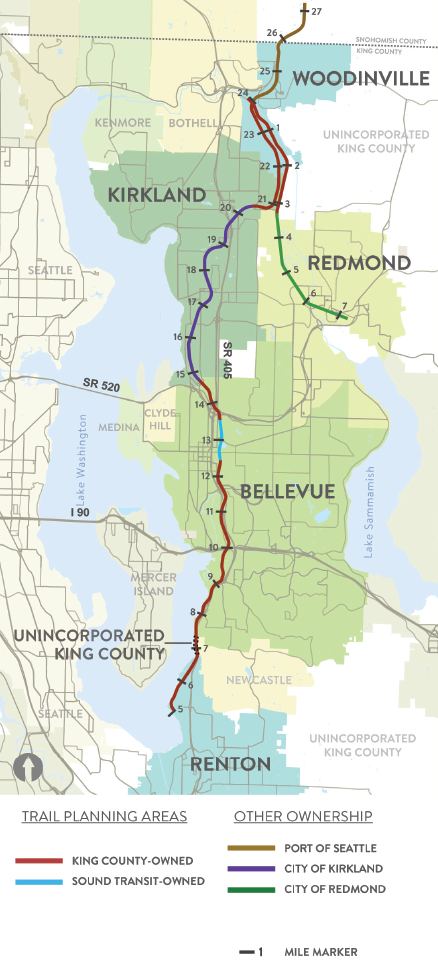Executive pulls first railroad spike as King County takes next step to expand world-class regional trail system
Summary
Elected and community leaders from across King County celebrated an important milestone as the County removed railroad spikes as a key step in developing the multi-purpose Eastside Rail Corridor, including a trail connecting East and South King County communities.
Story

King County Executive Dow Constantine pulled the first railroad spike of the County’s portion of the Eastside Rail Corridor, signaling the start of new work to expand its world-class regional trail system.
Once complete, the 20-mile corridor will increase transportation options and recreational opportunities across East and South King County.
The expansion in south Kirkland will provide walkers, runners, and cycles with a dedicated trail between Totem Lake to Montlake and connect high-tech companies to the University of Washington.
“Removing the first railroad spikes is an important milestone as we expand our world-class regional trail system,” said Executive Constantine. “We’re knitting together the growing communities in East and South King County and offering new options for transportation and recreation.”
Executive Constantine and Metropolitan King County Councilmembers Claudia Balducci and Rod Dembowski were joined by trail, cycling, and rail advocates, as well as Eastside business leaders.
The Eastside Rail Corridor—which connects Woodinville, Kirkland, Redmond, Bellevue, and parts of unincorporated King County—is owned and managed by King County, the cities of Kirkland and Redmond, Sound Transit, and Puget Sound Energy. The Eastside Rail Corridor (ERC) was purchased with the goal of developing a shared, uninterrupted multi-use corridor through the spine of east King County.
The County Council recently approved a proposal by Executive Constantine to improve operational efficiency and safety and enhance the ERC's function and value for recreation and other allowed uses. Phased rail removal will begin in early 2017, after planning and permitting are completed.
Project will double length of corridor without old rails
King County’s removal project would more than double the length of the corridor that is free of the old rails.
The cities of Redmond and Kirkland have removed and salvaged the rail tracks in their portions of the corridor. Sound Transit has indicated it will remove the rails on its portion in Bellevue in preparation for the construction of the East Link Wilburton Station and the Link Operations and Maintenance Satellite Facility.
Freight and other rail use on all but a mile of the Redmond spur were discontinued several years before the County’s acquisition. The condition of the old rails, ties, ballast, drainage structures, and other equipment in these unused portions is poor and requires costly maintenance.
Selling the removed rails would generate revenue that can help offset the cost of removal or support other corridor development activities. Market prices for steel at the time of removal will determine the actual revenue amount.
It is expected rail removal will begin at the ERC segment south of Kirkland, which has already removed rail and developed a trail through its portion of the corridor. It is likely King County would begin developing an interim gravel trail at that location, extending the length of usable trail within the corridor.
Relevant links
- Overview of Eastside Rail Corridor
- NEWS: County Council unanimously approves Executive’s proposal for rail removal
Quotes
Removing the first railroad spikes today is an important milestone as we expand our world-class regional trail system. We’re knitting together the growing communities in East and South King County and offering new options for transportation and recreation.
For over a decade, our county and our cities have shared a vision for this multi-use corridor as a tremendous benefit for the people of the region. The removal of the rails is the next step toward realizing that collaborative vision. As we proceed, we must ensure that residents throughout the county are engaged in the planning so that this unique regional asset will serve everyone.
Opening up a corridor roughly parallel to I-405 that will serve bikers, pedestrians, and alternative transit options is a game changer for the Eastside. The ERC’s multi-modal transportation options open up some very exciting.
For more information, contact:
Doug Williams, Dept. of Natural Resources and Parks, 206-477-4543

 Translate
Translate

